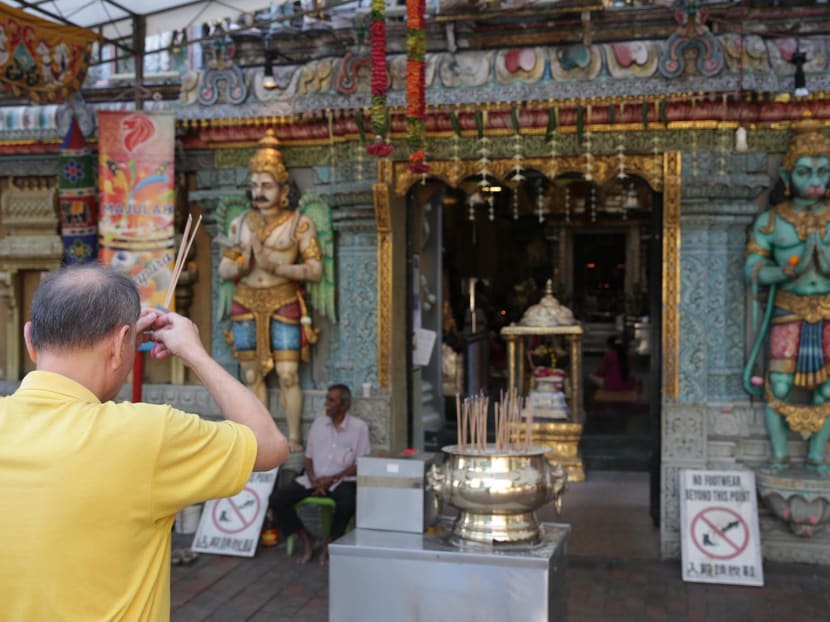In historic Kampong Bencoolen, a thriving league of faiths
A walk along the historic Kampong Bencoolen area is a journey across faiths, living proof of Singapore’s multiracial, multi-cultural, multi-religious society.
A walk along the historic Kampong Bencoolen area is a journey across faiths, living proof of Singapore’s multiracial, multi-cultural, multi-religious society.
At Waterloo Street, the 147-year-old Sri Krishnan temple, a South Indian Hindu temple, sits almost cheek by jowl with the famous Kwan Im Thong Hood Cho Buddhist temple — built in 1884 for devotees of Guanyin, the Chinese goddess of mercy.
A 10-minute walk away lies a cluster of churches. At Queen Street sits the Catholic Church of Saints Peter and Paul — built in 1870. Across the road is the 99-year-old Kum Yan Methodist Church, which sits alongside the St Joseph’s Church — completed in 1912 but now closed for renovation — and as the 57-year-old independent Grace (Singapore Chinese Christian) Church.
One of the Republic’s two synagogues, the 139-year-old Maghain Aboth Synagogue, is also located along Waterloo Street; in Bencoolen Street just behind it is the 172-year-old Masjid Bencoolen.
Marked out by Sir Stamford Raffles as the “European part” of Singapore, Bras Basah — which loosely translates to “wet rice” in Malay — was meant to serve as the suburb to the busy city centre which wrapped itself around Commercial Square, or the present day Raffles Place.
The result was an area where cultures and religions blended seamlessly alongside one another with a mix of schools, residential quarters and houses of worship.
Having different houses of worship in close proximity to one another is a “distinct regional identity” unique to diaspora communities like Singapore, said president of the Singapore Heritage Society Chua Ai Lin.
This “eclectic harmonisation may also be found in other space-constrained cities like Georgetown (in Penang)”, added Dr Chang Tou Chuang, from the National University of Singapore’s geography department.
The various religious heads often attend interreligious events and “know one another”, which has helped them build a peaceful and harmonious relationship over the years, Kwan Im Temple’s board of trustees chairman Tan Choon Kim told TODAY.
One interesting practice that has evolved as a result of the proximity is cross-worshipping.
Every day, swathes of Chinese temple-goers can be seen dropping by Sri Krishnan Temple’s entrance to place a joss stick in a giant urn and offer a reverent bow before proceeding to the Kwan Im Thong Hood Cho Temple. Some worshippers even give alms into a box set up outside the temple.
Even the temples’ management are not too certain how the ritual started. In the past, said Sri Krishnan Temple chairman P Sivaraman, Chinese worshippers would stand around the temple’s entrance, light up their joss sticks, and leave them lying around.
Worried that the joss sticks “put all over the place” would be a potential fire hazard, in the 1980s, Mr Sivaraman put a small urn at the entrance so that worshippers could place their joss sticks in it. In late 1980s, a chicken rice seller, who lived near the temple, donated the current larger urn which cost more than S$1,000 back then.
Nowadays, Mr Sivaraman said around 100 Chinese worshippers a day stop by the temple grounds. That number can increase to around 400 a day on weekends, and peak at 1,000 around the first, or 15th day of the lunar month.
Worshippers told TODAY they do it because it seems to be a common practice.
“I just follow what I see everyone else doing,” said Mr Eric Leow, a 49-year-old manager who has been visiting Kwan Im temple since his 30s.
Dr Chua said this practice of cross-worshipping is not uncommon among Chinese popular religion, given that “they are open to all kinds of sacred deities, and will respect different forms of spiritual power”.
Polytheistic religions, like Hinduism and Buddhism, are also open to praying to different deities. As NUS’ Dr Chang pointed out, worshippers might want to “hedge bets” by “paying respect to many gods as possible to ensure continued/future prosperity”.
As a 60-year-old worshipper, who wanted to be known only as Mr Yap, put it: “Well, you pray to more gods, the more luck you get, right?”










